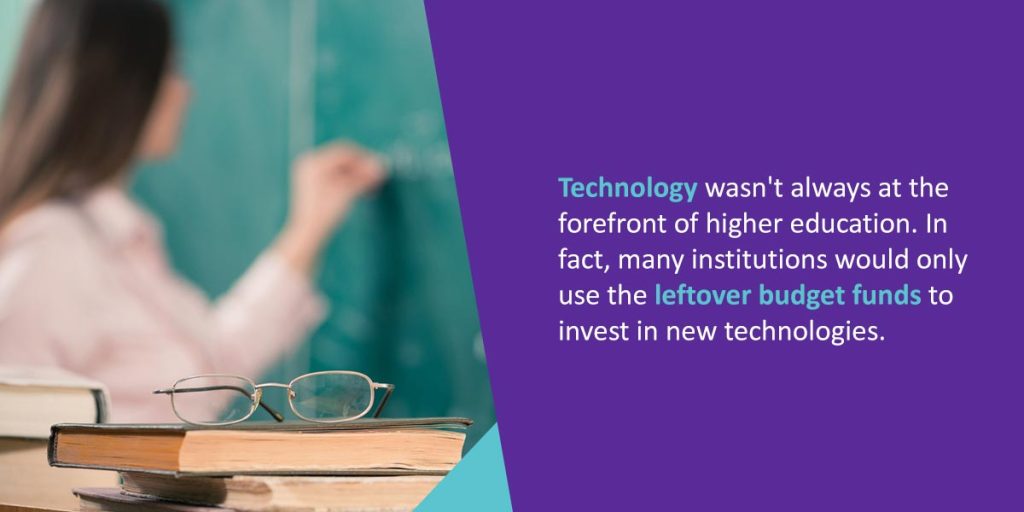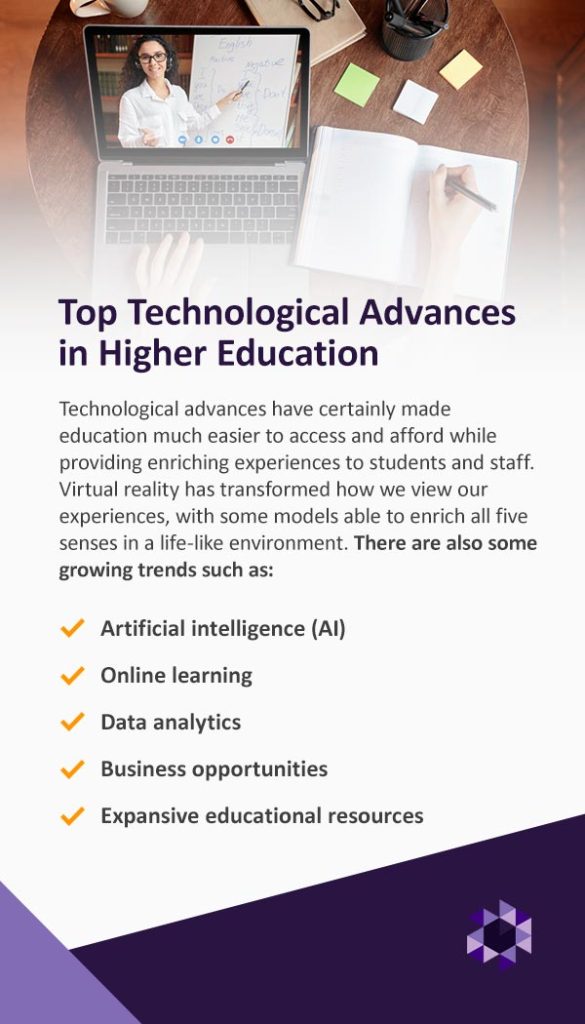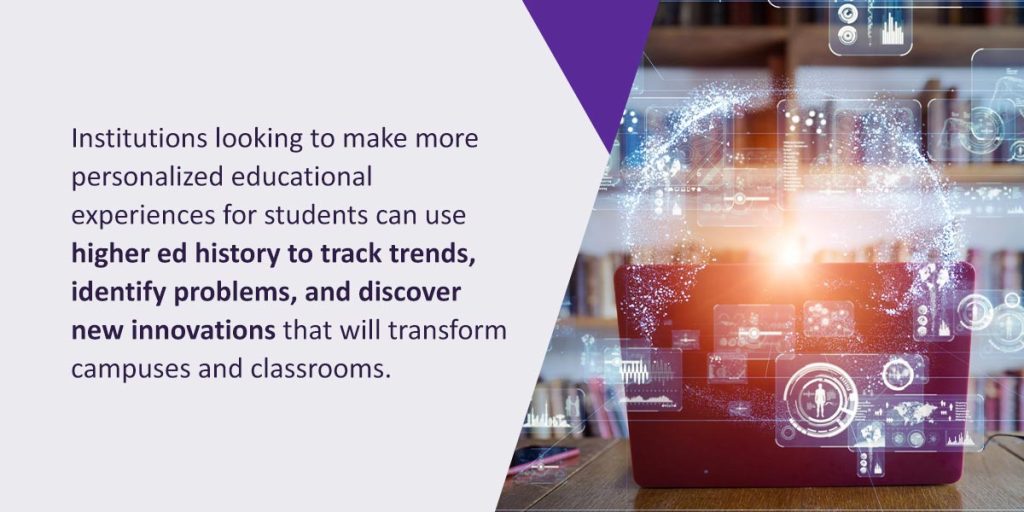The historical evolution of higher education in the United States is not as long of a story as some might think. Since its origins, higher education has transformed its missions and ideals, and it continues to do so today as we navigate ways to create personalized educational paths and drive students to success.
At first, higher education was a way to show religious faith or become knowledgeable about sciences and prestigious fields. Since then, higher education has transformed into a way to think critically about society, politics, and values, grow personally and intellectually, refine character, and form sensibilities. While many also believe higher education is a way to practice community service, recognize global perspectives, and understand democratic citizenship, others think it’s a way to prepare for the workforce and take the first steps toward upward mobility.
How Has Higher Education Changed Over the Years?
Religious groups founded some of the first American colleges and offered a range of liberal arts studies to foster faith in students. Often considered the first American higher education institution is Harvard University, which Puritans founded in 1636.
Eventually, institutions expanded to include more opportunities to craft a skilled workforce and promote science, agriculture, and technology. After this switch, institutions became a necessity for those wanting to advance in private sectors, and chemistry and physics departments started to expand.
Accreditation practices began in the late 19th and early 20th centuries. These practices created standards for higher education institutions to distinguish themselves from high schools and their curricula.
In 1944, President Franklin D. Roosevelt signed the GI Bill, which gave veterans funds for education. World War II soldiers did not need to pay for books or courses and received a monthly stipend to pay for housing and food.
It was at this time that the American Dream came to include higher education, and citizens started to see college as a means to a better life. The government began eliminating costs and giving additional aid to low-income students and marginalized individuals after the Civil Rights movement. People started understanding that a diverse student body created an enriching academic experience, and affirmative action policies appeared in the late 1960s.
The history of higher education in America shows that these institutions are a place for change. In the 1960s, college campuses were advocating for civil rights, women’s liberation, and free speech. Colleges and universities are hubs for sharing ideas, advocating for change, and ideating paths for progress.
Today, America has expanded the programs that institutions offer. Students can enroll in online classes and specialized courses, and seek creative career paths.

The History of Technology in Higher Education
Technology wasn’t always at the forefront of higher education, and even today colleges and universities struggle to incorporate technology into their programs. Despite these challenges, institutions have made use of a variety of technology over the years to create a greater educational impact for their students.
One example of early educational technology is the e-reader. These devices digitally store reading materials so that people can access multiple books at any given time. This technology made its first appearance well before the Kindle or iPad, with the first handheld e-book reader launching in 1998.
This e-book reader — known as the Rocket — enabled e-books to be downloaded on a PC through a serial cable. The SoftBook was another handheld e-book reader that emerged the same year. It could carry 100,000 pages of content, including pictures, graphics, and text.
The rise of similar devices in the following decades shows that e-readers are a particularly impactful technology. Today, students can use them to study, read their favorite books, browse the internet, and conduct research.
In the late 1990s, learning management systems like Blackboard started to be developed for higher education. These educational platforms allowed students to access classes, coursework, tests, and grades through an online portal. Blackboard is still a popular learning management system today, giving students the flexibility they need to access their course materials from anywhere.
Less than 15 years ago, institutions started to shift focus toward self-paced learning. Students began to develop master skills in a timeframe that fit their schedule. This innovative form of education is adaptable and enables institutions to provide personalized learning paths that guide students to their careers and goals.
New technology is being developed every day to enhance the educational experience and give students a hand in their own success. With such rapid technological advancements in higher education, many institutions can find themselves using tech that is ineffective or out of date. It’s important to keep track of trends to know when it’s time for an upgrade so you can ensure that your institution has the tools it needs to bolster student success.
What could Watermark do for your institution?
The Rise of Virtual Classrooms
While higher education once was only accessible in person, students no longer need to uproot their lives to participate in prestigious programs or take a course from their dream college. Today, students can learn from the comfort of their homes or their favorite coffee shop, all while balancing a full-time career.
Traditional classrooms have seen a plethora of technological advances over the years, and we can use this technology to create meaningful assessments and individualized pathways to success. Technology can encourage collaboration, motivate curiosity, facilitate coursework, and create opportunities. One of the greatest technological advancements in higher education has been the development of virtual classrooms.
After the COVID-19 pandemic, many institutions made the switch to virtual classrooms when meeting in person was unrealistic. Although many colleges and universities have returned to on-campus activities and classes, others still offer a variety of online classes and experiences to make education as accessible as possible. Higher education institutions can also use virtual classroom technology to encourage students to take courses from other universities. For some institutions, this technology has paved the way for the hybrid education model, where classes meet in person for one or two days per week, and the rest of the instruction is held online in virtual chatrooms and video conferences.

Top Technological Advances in Higher Education
Technological advances have certainly made education much easier to access and afford while providing enriching experiences to students and staff. Virtual reality has transformed how we view our experiences, with some models able to enrich all five senses in a life-like environment.
Wireless presentation technologies have streamlined the research and data collection process and made it much easier to work on projects and present findings in a straightforward way to other peers and instructors.
Smart campuses are also rising in popularity. These spaces are areas where people and smart devices can freely interact. Smart campuses feature technologies that alert them of problems, such as water leaks or broken faculty appliances, create engaging classrooms, and automate faculty and student processes.
There are also some growing trends such as:
- Artificial intelligence (AI): AI is everywhere in higher education. From library services and management systems to disability support and student information systems, artificial intelligence makes everyday tasks more manageable for staff. They can use AI to record and find information, providing students with quality academic materials.
- Online learning: Emergency remote operations are no longer a backup protocol. Institutions are using online courses and downloadable material to educate and instruct students from all over the world and give them resources they may not otherwise be able to access.
- Data analytics: Higher education institutions handle a plethora of information daily, but they don’t always know what to do with it or where to store it. Software enables your institution to use data to gather trends from student feedback or build and share your curriculum.
- Business opportunities: Online education is expanding to make receiving credentials easier and faster than ever before with specialized courses and boot camps. Students can take a course that lasts only 10 hours or less to receive badges, certificates, and licenses.
- Expansive educational resources: Online education is more affordable than many in-person courses, and institutions can offer databases of information or open educational resources that students otherwise wouldn’t have access to. Programs such as 3D data visualization even make it possible for medical students to dive deeper into complex materials and give other students the opportunity to investigate case studies or find peer-reviewed articles.

What Your Institution Can Learn From Higher Ed History
Higher education history shows us how far we’ve come and gives us an idea of where we’re going. Institutions looking to make more personalized educational experiences for students can use higher ed history to track trends, identify problems, and discover new innovations that will transform campuses and classrooms. Other institutions will continue to develop their technology, and you must prepare to do the same to stay academically competitive.
Among the lessons we can learn from higher education’s history are:
1. The Student Body Is Not Homogenous
As higher education institutions expanded beyond religious institutions and began to educate marginalized individuals, student populations became more and more diverse. Now, many current students come from low-income families, are part-time students, full-time workers, or otherwise seeking additional professional development. Because the student body is a large mix of students with different backgrounds, institutions should cater to every learner and meet their needs using a holistic approach.
Additionally, these student bodies are not passive. They form clubs, speak out, and recognize injustice. Higher ed institutions need to meet the needs of their students and encourage them to take leadership roles and seek other opportunities that promote growth and learning.
2. Institutions Can Serve This Variety
With advancements in technology come new varieties of students. Acknowledging that the student body is not homogenous also comes with the recognition that students may be transfers, commuters, adult learners, hybrid learners, or part-time students. These and other learners need technology that suits their needs, like options for hybrid or virtual learning. Colleges and universities can dedicate more resources to these students and make possession of other credentials, such as certifications and badges, more accessible.
3. One Size Does Not Fit All
Past higher education institutions ran under the assumption that every student would learn the same material at the same pace. Instructors would present loads of information to students, and learners would show knowledge through exams and other assessments. Those who wanted additional challenges would seek them out independently and take charge of their advancements on their own time.
Now, we recognize that every student learns differently. While some prefer auditory lectures, others prefer hands-on projects or reading textbooks. Many others enjoy a combination of more than one learning type and prefer courses that don’t rely on one form of learning. To aid learners through their academics, higher education institutions need to implement self-paced, adaptable, interactive, immersive, and personalized solutions for students that drive them to ask questions and seek their own unique paths.
How Watermark Is Changing the Higher Ed Landscape
Watermark is dedicated to delivering your institution data measurement, analysis, and collection solutions. We enable you to uncover trends and develop plans that create personalized educational paths for your students. We know technology will only continue advancing, and navigating new programs and software is one way you can stay ahead of the game and provide your students with an enriching education.

Learn More About Watermark and Technology Use in Education
Our software helps you meet institution initiatives, reduce drop-out rates, increase student retention, and promote a sense of lifelong learning for your students. We can also help you stay competitive with other institutions because our solutions allow you to track trends and monitor student progress. You’ll be able to identify areas where your institution needs to dedicate more time or resources.
Our Faculty Success helps take the strain off of your staff members by reducing the number of repetitive tasks they need to perform daily. You can also use this software to make reporting more manageable and identify critical processes, such as tenure and promotions. With configurable reports available, your institution can find data on the accomplishments of other staff members, and interested students can see the qualifications of your staff.
Student Success & Engagement, our student retention software, can also transform your institution. You will be able to identify and engage with at-risk students and develop intervention strategies that motivate them to complete their program. The data you receive will enable you to boost productivity and connect with your students.
Request a demo of our software solutions today. Start using award-winning software you can trust to stay on top of tech trends and improve your students’ experiences.















































































































































































































































































































































































































